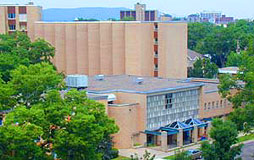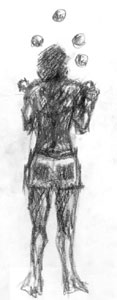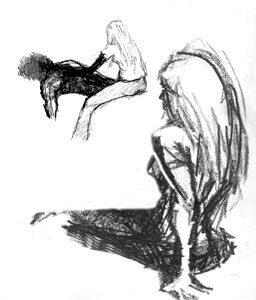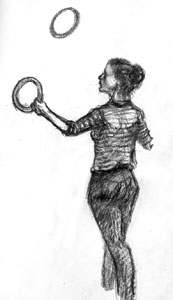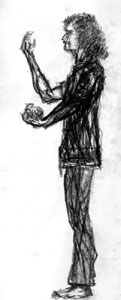Theatrical
Daze & Nights IIb
"LaCrosse" the Mighty Mississippi
-- International Mime Festival 1974
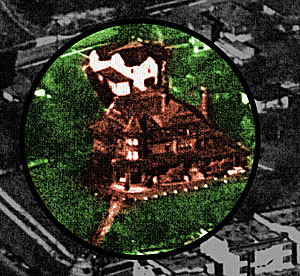
*The McCune Mansion on upper
State Street.
We rented the elegant carriage house in back. |
Summary
of Part IIa:
The Salt Lake Mime Troupe took over the carriage house
of the McCune Mansion on Capitol Hill as 1973 became 1974. We also took on a new
professionalism, or at least tried.
I assisted Katie Berger with her classes at University Utah by videotaping her
and her students. She and Patsy Droubay also taught workshops at the Hillside
Studio, our name for the carriage house, since the front door was on Hillside
Avenue.
Daniel Robert, our friend and manager from New York, took a couple
of bold steps on our behalf -- he booked us at the Sun Tavern, one of the first
openly gay discos in Salt Lake, or the Western USA. Everyone who went there wanted
something out of the ordinary, and they loved our show! We first worked out of
state in Steamboat Springs, Colorado in the spring, and
Daniel then decided to send Matt Child, Katie, Dave Carrillo, and Patsy Droubay
to LaCrosse, Wisconsin for the International Mime Festival and Institute. |
During
one of Katie's movement workshops in May, a Kindergarten teacher named George
Kugler from Seattle, Washington showed up after reading one of our brochures.
He was a tall, strong, bearded man with a gentle disposition and a fierce eagerness
to learn. He enjoyed Katie's classes so much that when he read about about the
International Mime Festival he registered by mail and took off for the Midwest.
(I'll tell more about him later.)
I made one of the most important personal
decisions of my life when I gave up my industrial job to follow our dancers to
LaCrosse along with our new band. Paul Blackwell and Stuart Curtis had joined
forces with a hard-rocking drummer named Fred and a proficient bass player named
Bud. They enjoyed
mixing up time-signatures, and the dancers enjoyed the new rhythms too. Customers
in the bars liked their music LOUD, and our band delivered the high-decibel goods.
The International Mime Festival was really a TRIP -- we drove my red Volkswagen
over the Wasatch Mountains into Wyoming. Then roared on through the night through
Nebraska, and Iowa with the Northern Lights shining on our left. After a short
sleep-over in an Iowa field, we drove among the islands of the upper Mississippi
in the Wisconsin Dells until we descended from the high bridge into LaCrosse and
located Viterbo College, the host of the event.
We asked around and
found Matt, Katy, Patsy, and David at a lecture-demonstration featuring Dimitri
the famous Swiss clown. Dimitri had been scheduled scheduled to leave later that
week, but he stayed throughout the whole festival because of the exciting energy
there. He even performed a second show later on because so many people wanted
to see him perform again. He spoke very passible accented English and his wife
was along to help him out, but he had no trouble communicating with anybody. In
person he was bright, open, friendly, and flashed the widest smile in the entire
world.
The dancers made room for us in the dormitory, and the rest of the
first day was a blur of getting aquainted with the other participants, and sleeping
off the thousand-mile dash in my Volkswagen. It didn't take too long to discover
that LaCrosse was the home of the Heileman Breweries and that there were more
bars and liquor stores than any other kind of business there
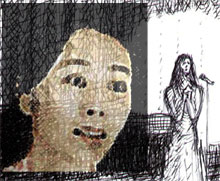 *Mamako
made friends with everyone she met. She began her main stage performance singing
a nightclub song in English. *Mamako
made friends with everyone she met. She began her main stage performance singing
a nightclub song in English. | 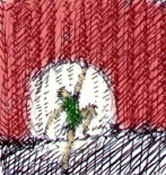
*Mamako also did satire about
oxygen masks in the Tokyo subway, and a pantomime fairy tale. |
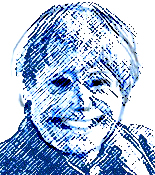 *Dimitri,
the Swiss clown, played 17 instruments during his astounding show. *Dimitri,
the Swiss clown, played 17 instruments during his astounding show. |
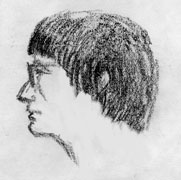
Antonin Hodek was a kind, friendly Czech
expatriate. The other acts from his country ranged from brilliant to stodgy. |
A particularly large club on Main Street had live music every night, and I found
myself down there the next evening dancing with a proper, sophisticated Japanese
lady named Mamako Yoneyama, who was considered an Eastern Goddess among Mime professionals.
She enjoyed hearing everybody's stories about where we came from, and our dreams
and goals. If you didn't fall in love with Mamako just a little, then you never
met her. Earlier that same day, another friendly individual named Antonin Hodek,
originally from Czeckoslovakia, walked right up to me when he saw me packing a
camera, and told me of the photos he shot on his journey between Los Angeles and
LaCrosse. Two of them were significant to me -- a wild white horse in Wyoming,
and an angelic beam of light from the clouds over Salt Lake City.
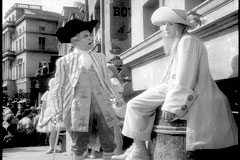
*Ettiene DeCroux abuses stage-son
Jean Louis Barrault in public just before the mild actor becomes a star portraying
Pierrot. | 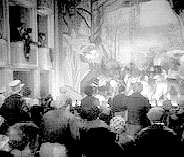
*We almost started a riot in
the theater when this Harlequinade was cut short in the movie. | 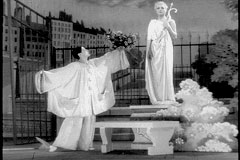
*Barrault, playing Baptiste
Deburau as Pierrot, later kills a clothing vendor, played by his father,
played by DeCroux. |
The next significant episode I remember was a showing of Les Enfants du Paradis
(Children of Paradise) at the main theater. Jean-Louis Barrault was outstanding
as Jean Baptiste Deburau, the man who made Pierrot, the whitefaced Commedia
Dell 'Arte character, so popular in the 19th Century. The absent Marcel Marceau
owed much to Deburau, Barrault, and Charlie Chaplin for his famous silent character
Bip. The movie also featured Etienne DeCroux, Marceau's equally-renowned
teacher, as the blustering patriarch Anselme Deburau. The crowd was very upset
when it looked like Baptiste's big onstage break was interrupted. We raised a
noisy un-mime-like fuss until the projectionist came down front and told us the
film was simply cut that way. (I wonder if any restored version shows the whole
Commedia?) We later saw some other films which relied on action rather
than words, but the best was a black and white short by Etienne DeCroux which
I'll describe as a hard-edged modern dance in leotards and masks on a checkered
stage.
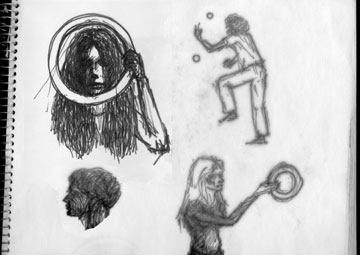
Drawings from my sketchpad
-- my first workshop was
Hovey Burgess' basic juggling class. |
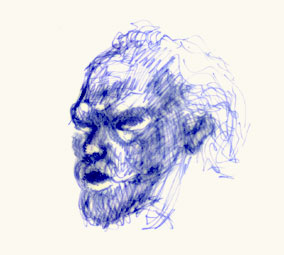
Burgess
trained clowns and acrobats for the
Barnum
& Baily Circus. He also taught at NYU.
|
A circus trainer from New York University named Hovey Burgess was on hand, along
with his wife Judy Finelli. He carried duffel bags full of rings, sticks, and
heavier balls with which he was able to teach the rudiments of juggling to dozens
of people at a time. One of the first sights I beheld from my dorm window was
a statuesque dark-haired lady in the garden practicing the 'cascade' pattern.
Her name was Nancy and she'd obviously had some training. She regularly helped
out the neophytes, including me, in the cool mornings before classes began. Before
long, groups of people were everywhere on campus -- juggling some damn thing or
combinations thereof. Hovey was often to be found lurking around these clusters,
usually passing clubs with Judy as his partner. After
only a year of learning to be a theater technician, the idea of physically performing
myself was still strange. The aesthetic atmosphere was impossible to resist though,
and I participated at first by doing the kind of art I had already trained to
do. I'd left my video gear behind, and photography was as new a thing as theater
to me. I took out my sketch pad and went to work -- learning by drawing. The very
first class I attended, as a sketching spectator, was one of Burgess' basic workshops,
where he demontrated how patterns of balls led to rings, and rings led to sticks,
which led to clubs, and how two led to three, or two led to four, or five, and
-- well he ended the demonstration juggling battle-axes while balancing on a stack
of crossed steel cylinders. (Note: LaCrosse balls, preferred by jugglers, were
not available in LaCrosse, but Hovey somehow bought his battle-axes there.)
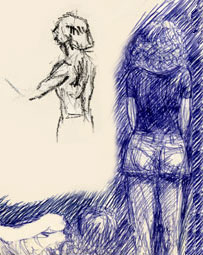
The constant juggling sessions
attracted many spectators at first, but EVERYONE participated at last. | 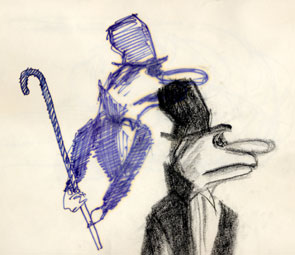
One young African-American man from San Francisco brought his rod puppet, demonstrating
how he made his living on the streets there. | 
*The Festival sponsored a field trip north to Baraboo, Wisconsin.
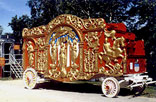
*The Circus World Museum in Baraboo had some dandy old equipment, and lithographed
posters from another time. |
Later that week, we all took a trip en masse to Baraboo, Wisconsin, once
the winter quarters for the Barnum & Bailey Circus. Dimitri was there, as
were Czech expatriates Pavel and Citor. The circus graphics and memorabilia were
fun to see, but the tired clowning under their big top was getting to be a drag
until some young inmates from the Mime Festival started getting into the act.
The old cynical carny in center ring even showed some life before we were done.

Masks were always a fun way of overcoming inhibitions. | 
The "Neutral Mask" revealed your body's attitudes when you wore it. | 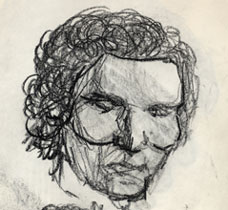
This gentleman was one of our
roomates in the dorm. | About
this time, it became clear that the hapless festival management was outnumbered
and overwhelmed by the professional and carnal desires of more than a hundred
twenty-something men and women. Across the street from the main theater was a
place named the Wonder Bar, where beer sold for ten cents a glass. After dark,
the REAL festival convened THERE. (Help Me Rhonda, and Chuck Berry's full-length
single of Reelin' & Rockin' were on the jukebox.)
The festival
attendees quickly noticed that the European acts outclassed the Americans every
time, and that "Mime" was much more than aping Marceau's famous moves
-- it was an ancient synonym for "Theater," with the same objectives:
Strength, skill, surprise, and artistic insight were all-important keys to an
audience's appreciation.
European artists like Citor Turba and Mummenschanz
followed Dimitri's lead in shattering everybody's preconceptions, and lifting
the proverbial bar of achievment high above the heads of even skillful Americans
like Bobby Shields -- a strong, attractive performer who was commercially successful
at the time, but is now largely forgotten, or too often on the receiving end of
unfair jokes. There were other shows by "establishment mimes," but they
tended to be threadbare or dull. One or two were actually awful, but I won't even
hint at their names.
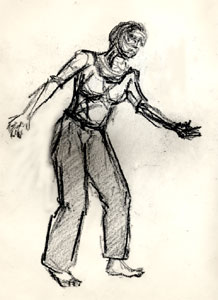
Joan Merwyn was from San Francisco,
and already
knew
performers
like Noel Parenti, Linda Yarnell, Bobby Shields, and James Donlon. |
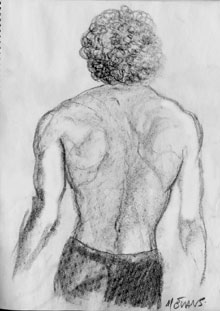
James Donlon was relatively progressive,
and an inspiration to our choreographer Katie, who sought to create new theater. |
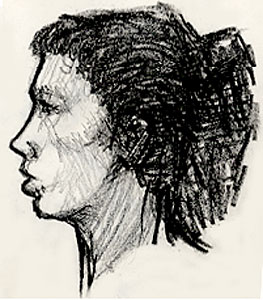
Joan's roomate Nancy was from San Francisco
too. She possessed an all-encompassing positive energy which never failed to inspire
the others who came to learn. |
I could have behaved myself a lot better during the performance of fellow American
Noel Parenti, but I laughed, and laughed hard, despite his unusual ideas and powerful
technique, because it struck me more like bad conceptual art than theater. (I
had been fortunate to know Paul McCarthy, one of conceptual art's GOOD practitioners.)
Noel was a great tap dancer, and an even better man, who forgave me for my rudeness,
accepting me as a friend. He enjoyed partying, and it was fabulous hearing stories
from him, plus joining-in his physically excrutiating early-morning warmups.
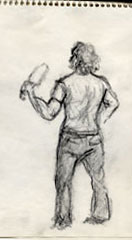
Burgess spent hours outside every day
passing clubs with his wife Judy Finelli, and teaching simultaneously. |
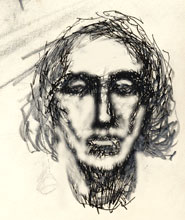
Noel Parenti was a gentleman & scholar
with no living equal wearing tap shoes.
Seiji Ozawa later wrote Symphony For Tap Dancer and Orchestra especially
for him. | 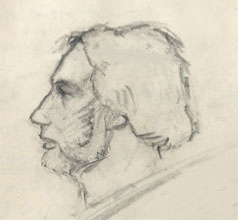
Carlo Mazzone-Clementi toured in an
international Commedia Dell' Arte production with Marcel Marceau after
World War II. He spent much of his leisure time at LaCrosse with the Friends
Roadshow. |
Hovey repeatedly emphasized the underlying strength and inspiration feeding into
tradition forms like circus, and his Italian colleague, the great Commedia
Dell' Arte master Carlo Mazzone-Clementi backed him up. When Jacques Lecoq
arrived from Paris for his week-long workshop, it was official: Everything
You Thought You Knew About Mime Was WRONG! It was actually an exhilirating
and liberating idea rather than a disappointment.
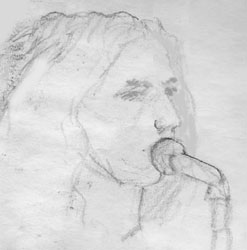
Stan (Jango) Edwards anchored
an international amalgamation of talented performers called the Friends Roadshow. | 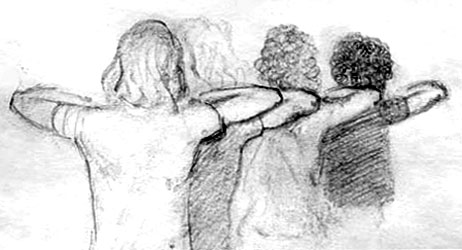
Rehearsing "Rockin Robin"
with (L to R) Carl Holmer, Ted Van Zutphen, Mike Lynch, and Rick Parets. Backed
by a funky jazz band, Friends Roadshow wove visual clowning, stand-up comedy,
high and low art together into a colorful warp of theatrics. |
Just
when it seemed like things couldn't get crazier, Friends Roadshow drove
in from Michigan with a small fleet of Ford trucks -- towing a portable stage,
a funky electric band, a bevy of beautiful women, and scraggly long-haired men
from all over Europe and America -- making everybody laugh with good songs, daffy
comedy, and energetic physical performances. There were some talented female singers
with them, and a precocious lad named Justin Bishop-Hammer, but otherwise they
looked like a shaggy soccer team. Their company's letterhead said they had companies
in London, Paris, Amsterdam, the USA -- and Salvador Dali was their patron.
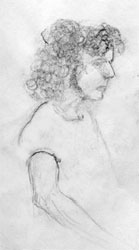
Mike Colone, the lead guitarist,
was soon replaced by Cedric Curtis from London. | 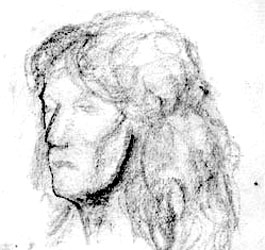
I never personally met Chris
Kelly, their British drummer, but I got to know Sean Bergin, Friends' masterful
saxophonist from South Africa. | 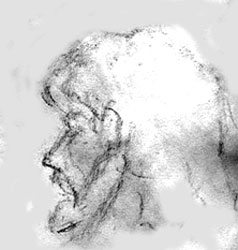
Keyboardist Davy Norket led
the Friends' Band. Few bass players could underpin his funky left hand,
so they often toured without one. | The
Salt Lake Mime Troupe had already created a sensation or scandal, depending on
who you asked, by taking over one of the performance spaces and putting on our
own full-length show. I led the way in staging this coup, simply because I saw
that Katie, Matt, Patsy, and Dave did work which was better than ninety percent
of everything else presented at the Festival. Our performance was very well-recieved,
but we made some waves nevertheless.
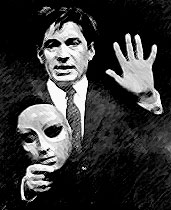
*Jacques Lecoq was a wellspring of practicality. Julie Taymor and Footsbarn Theatre
studied with him in Paris. | 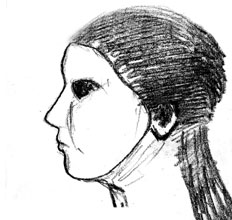
Patsy Droubay still looked like Patsy with a mask. She always expressed her emotions
very well in movement. | 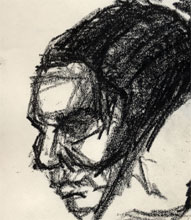
David Carrillo couldn't hide behind a simple mask either. He and Patsy partnered
well onstage. | 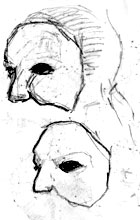
Katie took Lecoq's workshop
and explored her personal clown. |
When I spoke with Jango Edwards, the leader of Friends Roadshow, he suggested
that we would do well in Europe, and he said could help us secure some venues
there. He kept that promise within the year, but there was a lot more work ahead
of us. In the meantime, we practiced our new-found skills all day and enjoyed
being young all night during the warm beautiful summer evenings.
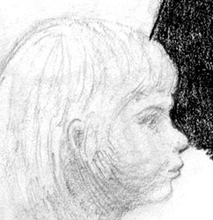
Young Justin Hammer was Jango's fearless partner in a variety of routines. | 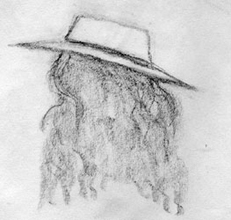
Justin's mother Karen Harvey later led
Sail-Joya, a fine Amsterdam
pop group. | 
Roxanne Kelly sang the show-stopping
"Taste Me" in the Friends'
revue. | Friends
Roadshow played outdoors in Viterbo College's Rose Garden (under the windows
of the on-campus convent), but they also booked themselves into the same boogie
joint where I'd partied with Mamako, and filled the Wonder Bar to overflowing
with de facto block parties more than once.
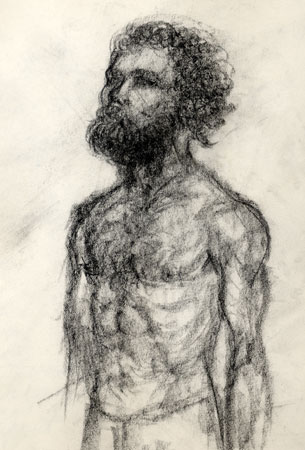
George Kugler, drawn while he was shooting and catching Ping Pong balls from his
mouth, in the busy garden outside of the Viterbo College dormitories. |
More
About George
Our pal George Kugler turned out to be an apt pupil when it came to clowning and
juggling.
He immediately innovated a wide range of tricks into an act
all his own, with a new character to go along with it.
One
trick he learned early was juggling Ping Pong balls with his mouth, after Dimitri's
example.
He had observed the whole scene with a canny eye, and did us
a great honor by asking to join us back in Salt Lake City.
We accepted his
offer, and never made a better decision. | 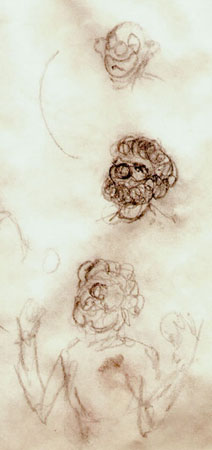
George committed himself totally to the art of entertaimnent for the rest of his
life.
A Friend's Reminiscence
-- RIP |
To top off the whole thing, Nixon resigned during the last week of the festival,
and we had the greatest celebration EVER, outside in the garden of the dorm. (The
local radio station played Wet Willie's Keep On Smiling at the end of his
speech.) Just before we drove off for Salt Lake, we watched the last part of a
W.C. Fields movie on TV in the cafeteria, with a finale featuring Fields' madcap
juggling in front of, and underneath, an erratically falling curtain.
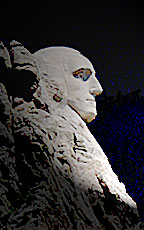
*George Washington's profile
was the last thing we saw before morning dawned in Wyoming. | 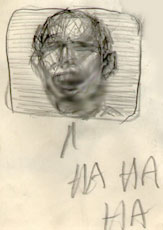
"Pardon ME!"
A TV fantasy drawing of President Ford hearing about
Nixon's resignation. | 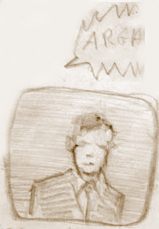
Press Secretary Ron Nessen telling a grateful USA we had a new President on fantasy
TV. | 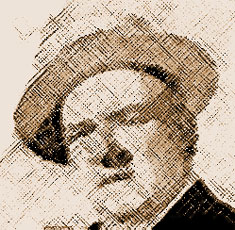
*On the day we left LaCrosse, there was a W. C. Fields film on the local TV station.
He was a theatrical juggler, and silent comic before he made movies. |
On the way back, we stopped in Sioux Falls to visit with recently-graduated allies
of ours from the University of Utah's Dance Deptartment. We ran out of gas in
the VW once. Luckily we were in a little convoy, and lost almost no time. We saw
Mount Rushmore in the fading blue evening, and made a less-than-wise decision
to drive all night after dinner in Rapid City. George Washington's huge profile
looked awesome under the floodlights as we began to navigate through the Black
Hills, but after that we saw nothing but darkness until the dreary brown hummocks
of Wyoming dawned into view. Coffee and breakfast worked wonders. I said "Buck
up, Buck!" to Matt, and we made it to Salt Lake by mid-afternoon, thanks
to those angelic beings who protect fools and children under these circumstances.
We were elated with new ideas and newfound confidence, but were also dead broke,
and would need all of Providence's help in the days to come.
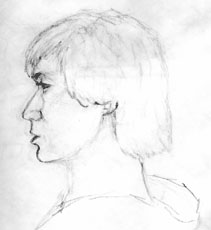
Han Arai from Tokyo roomed
with martial artist Sojo Sato. "We do a NEW Kabuki," he said proudly. | 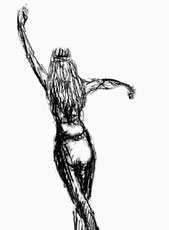
One of two existing studies of Deborah Hond, who stayed a floor below us in the
dorm.. | 
Study #2 -- Deborah also sat for a formal portrait. She liked it enough to keep
it -- plus show it to Katie. | 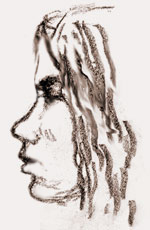
Another lady named Debbie was in the Friends Roadshow entourage. |
(
Continued
in Part
IIc
)
|




